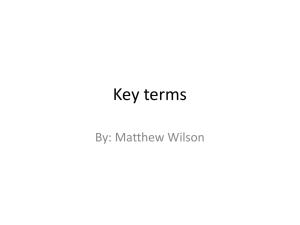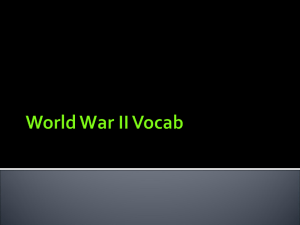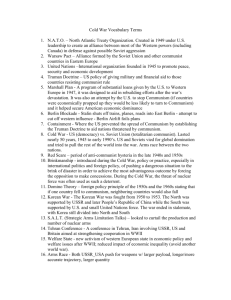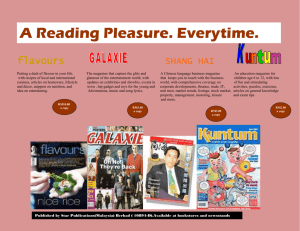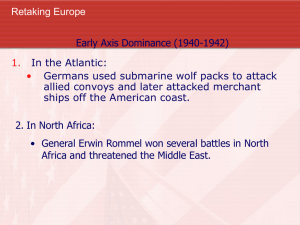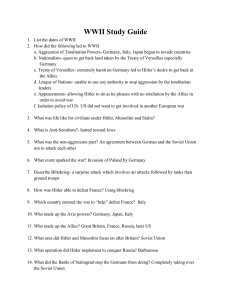The cold war
advertisement
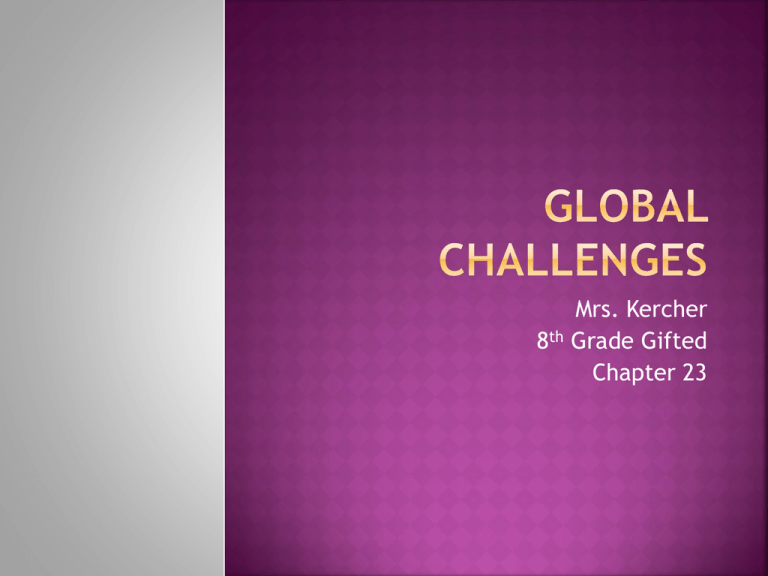
Mrs. Kercher 8th Grade Gifted Chapter 23 What challenges did the world’s nations face in the late 1900s and early 2000s? Think About: World War I World War II The Cold War The Vietnam War Terrorism Global Interdependence The onset of WWI can be traced to nationalism, imperialism, and the buildup of military forces in Europe. The killing of Archduke Francis Ferdinand, the heir to the Austro-Hungarian throne led to a split in the European alliance system. Why did many European nations form alliances? The Allies’ victory over the Central Powers came soon after the U.S. entered war. The Germans used submarines to sink ships bound for Britain because they wanted to stop the English from receiving food and supplies. The Germans did not win a swift victory because trench warfare created a stalemate that lasted for years. German forces received strong resistance from French and British forces. Why would other countries become involved in a war between two warring nations? The Treaty of Versailles changed the map of Europe and created resentment. The allies redrew the map of Europe because they believed nationalities should rule themselves. President Wilson wanted to create a League of Nations to promote democracy and prevent future wars. What impact did the conditions imposed on Germany by the allies have on the German economy? The Russian Revolution resulted in the world’s first Communist state. Czar Nicholas II was the ruler of Russia who was forced to give up control in 1917. Communism is a political system in which the government owns all businesses and controls the economy. The Russian Revolution was caused because of poverty, wartime, food shortages, and heavy losses of life. Why was Vladimir Lenin able to gain support to overthrow the government? Read pages 662 – 665 and reflect on: Why did many European nations form alliances? Why would other countries become involved in a war between two warring nations? What impact did the conditions imposed on Germany by the allies have on the German economy? Why was Vladimir Lenin able to gain support to overthrow the government? Think about the different news magazines that you have seen at bookstores, newsstands, or in the library. What is featured on the cover? As you read this chapter, look for people or events that could be the subject of a cover story for a magazine from the time period you are studying. When you finish reading this chapter, choose an event or person and create a cover pages for a magazine and write a short article about this subject for your cover story. Take notes on important people who played key roles during WWI. Be sure to list supporting details about what these people accomplished. (p. 665 # 6) Another global conflict, WWII, pitted the Allies against the Axis Powers from 1939 to 1945. The Axis Powers were Germany, Italy, and Japan. The Allies were Great Britain, the USA, Soviet Union, and France. Adolf Hitler was the leader/dictator of Germany. Benito Mussolini was the leader/dictator of Italy. After the attack on Pearl Harbor the U.S. fought with the Allies against Japan and German forces. What strategy did the Allies use to defeat Germany? The results of WWII included a staggering loss of life and a new power struggle between the U.S. and the Soviet Union. The war with Japan ended with the U.S. dropping two powerful atomic bombs on Hiroshima and Nagasaki. The Holocaust was an attempt by the Nazis to wipe out Jewish people. The United Nations was formed as an attempt to prevent another world war. Was the atomic bomb a good way to end the war with Japan? The Cold War was a period of tense rivalry between the U.S. and the Soviet Union. Germany became divided as a result of the West side becoming a democracy and taking economic aid from the U.S. The East side became a communist nation siding with the Soviets. In what way did the Cold War extend to Asia? Read pages 666 – 669 and reflect on: What strategy did the Allies use to defeat Germany? Was the atomic bomb a good way to end the war with Japan? In what way did the Cold War extend to Asia? Think about the different news magazines that you have seen at bookstores, newsstands, or in the library. What is featured on the cover? As you read this chapter, look for people or events that could be the subject of a cover story for a magazine from the time period you are studying. When you finish reading this chapter, choose an event or person and create a cover pages for a magazine and write a short article about this subject for your cover story. Page 669 – Complete #4 – Make a list of key events of WWII. For each event, write a sentence about the key people involved. Colonialism ended after WWII as countries in Asia, the Middle East, and Africa gained independence. Colonial rule changed after WWII. European countries lost rule over their colonial empires. Gandhi was the leader of an independence movement in India. In 1947, the United Nations voted to divide the Palestine Mandate, formerly under British control, into Jewish and Arab states. Why would the U.S. and the Soviet Union have been interested in gaining the support of African countries? The Cold War ended with democracy on the rise and Communism in retreat. Both the U.S. and the Soviet Union built huge numbers of missiles, bombers, and nuclear weapons as part of the Cold War. In what way was the Cold War a battle of ideologies? Why did the government of Eastern Berlin feel compelled to build a wall separating East Berlin from West Berlin? What was North Korea’s purpose in invading South Korea? The U.S. became involved in the Vietnam War to keep South Vietnam from becoming a Communist country. The Cold War impacted the Soviet Union’s economy. Things became very costly to attempt to keep up with the American military buildup. Gorbachev’s reforms in the Soviet Union sparked reform movements in other Communist countries. How has China blended the political ideology of communism with the economic practices of capitalism? Worldwide terrorism has become a great threat to peace. Terrorists acts include: shootings, bombings, kidnappings, and hijackings. Terrorist attacks have become more common and deadly in the 1900s. The goal of the Irish Republican Army was independence for all of Ireland. Osama bin Laden was a Muslim extremist who used the terrorist group, al Qaeda, to wage acts of terrorism against the US. President Bush invaded Iraq because he believed Iraqi leader, Saddam Hussein, was a threat to Americans. Worldwide terrorism has become a great threat to peace. In what way is terrorism unlike a war between nations? Why will it take cooperation to end the threat of terrorism? Global interdependence creates new opportunities and challenges. The global economy refers to the linking of nations around the world in a single economic network. Technology furthers the development of the global economy by connecting countries (individuals) around the world within a few seconds via an internet connection. How do you think the future will be impacted by technology? Global interdependence creates new opportunities and challenges. Wangari Maathai was honored by the Nobel Peace Prize for her efforts in planting millions of trees across Africa. Currently, sixteen nations work together on building a space station in space. Why do you think the Nobel Committee honored the Green Belt Movement? What challenges do you think will be faced and overcome in future international relations? Read pages 672 – 679 and reflect on: Why would the U.S. and the Soviet Union have been interested in gaining the support of African countries? In what way was the Cold War a battle of ideologies? Why did the government of Eastern Berlin feel compelled to build a wall separating East Berlin from West Berlin? What was North Korea’s purpose in invading South Korea? How has China blended the political ideology of communism with the economic practices of capitalism? In what way is terrorism unlike a war between nations? Why will it take cooperation to end the threat of terrorism? How do you think the future will be impacted by technology? Why do you think the Nobel Committee honored the Green Belt Movement? What challenges do you think will be faced and overcome in future international relations? Think about the different news magazines that you have seen at bookstores, newsstands, or in the library. What is featured on the cover? As you read this chapter, look for people or events that could be the subject of a cover story for a magazine from the time period you are studying. When you finish reading this chapter, choose an event or person and create a cover pages for a magazine and write a short article about this subject for your cover story. Page 679 – Complete #6 – You’ve just read about other important events and people from the most recent period in history. Would one of these events or people make a good cover story for your magazine? Make a list of any topics that you would consider writing about. Page 682 – Complete # 20 – Review your notes and decide whether you will write about a person or event. Which do you think would make the strongest cover story for your magazine? What are the important facts that you will need to include about your subject? How will you help your reader see why your subject was important enough to be featured on the cover of a magazine? Once you have decided on your topic, write an article about your chosen subject.
